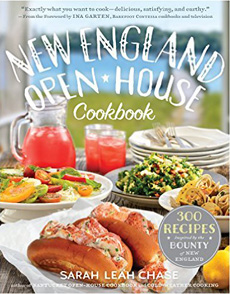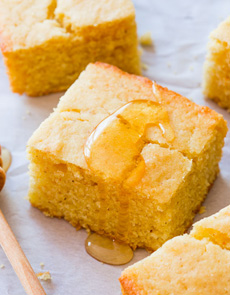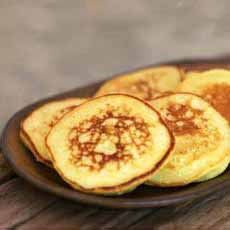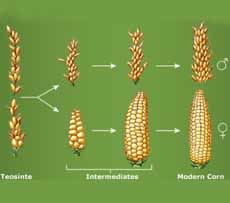Skillet Cornbread & More Cornbread Recipes
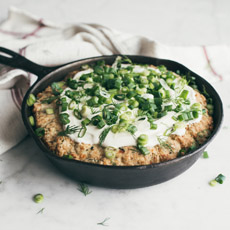 [1] The earliest cornbread was made in a skillet: Rectangular baking pans were not yet in use. This recipe is courtesy…
|
Serve this skillet cornbread for breakfast with eggs. Or serve it for lunch with a bowl of hearty soup and/or a salad. The recipe is from the New England Open House Cookbook via Vermont Creamery, which used its exquisite cultured butter and crème fraîche. Chopped scallions create a piquant counterpoint to the rich dairy. The garnish is optional, but adds excitement to an already yummy dish. Crème fraîche or sour cream, plus fresh chopped scallions, are a delightful finish. We have three more cornbread recipes for your perusal: Ingredients 1. PREHEAT the oven to 375°F. Mix together the cornmeal, flour, sugar, salt, baking powder and baking soda in a large bowl. 2. WHISK together in another bowl the milk, buttermilk and eggs. Pour in the melted butter and stir well. Add these wet ingredients to the dry ingredients and stir till combined. Gently fold in the corn kernels. 3. POUR into the prepared cast iron skillet. Bake for 25-30 minutes or until done. 4. TO SERVE: Top with crème fraîche and a sprinkle of scallions. |
|
|
THE HISTORY OF CORNBREAD Corn, which originated in what today is Mexico, was turned into flatbread–the tortilla—in its native land. Leavened breads were not indigenous, and the concept of raised bread wasn’t known until the arrival of the Spanish. As corn spread from Mexico northward, it was cultivated by Native Americans across the southern region of what is now the United States. When European settlers arrived, they learned to cultivate and cook corn from the Cherokee, Chickasaw, Choctaw, and Creek. The North American natives had also learned to make another unleavened cornbread, in the form of flat oval cakes or loaves. Mixing cornmeal and water, they cooked the batter in hot ashes. The Europeans called it cornpone, or pone. Pone is a shortened version of the Virginia Algonquian word for bread, appone; although pone is fried cooked gruel rather than flatbread (the fine points can be argued, but not here and now). |
||
|
The immigrant Europeans added some salt and fried the mixture in lard in their skillets. Skillet breads, pies, etc. date back generations before people had home ovens, much less baking pans. Everything was cooked over a fire in a cast iron pot or a skillet; or in some towns, in a central community oven. In parts of England, hoe was a colloquial term for griddle. The tale that hoe cakes were cooked by field workers on their hoes over a fire is a story perpetuated but not substantiated. The fried corn batter is also known as hoe cakes and johnnycakes. Today, outside the South, we call them corn pancakes. Here’s a recipe for hoecakes and for johnnycakes; the photos are below. The immigrants adapted cornmeal to their European recipes: bread loaves and muffins, corncakes, fritters, hoecakes and pancakes, liquor, porridge and so on. Most people had little cooking equipment. The skillet served multiple purposes, from frying to baking. Cornbread became popular as the main ingredient for a dressing or stuffing with fowl (the difference: stuffing is cooked inside the bird; dressing is cooked in a separate pan). Cornmeal is produced by grinding dried raw corn grains. The finest grind is used for baking, a medium grind for porridge and polenta, and a coarse grind for grits. Raw corn kernels spoked in hot water and an alkaline mineral like calcium hydroxide is called hominy (pozole in Spanish) and ground and mixed into masa harina, the dough used to make tamales and tortillas. Cornbread can be baked or fried, even steamed. Steamed cornbread is more like cornmeal pudding or mush, moist and chewier than a traditional bread. Here’s more on the evolution of cornbread plus early cornbread recipes. One thing to note: Originally cornbread did not contain sugar. As disposable income increased, this expensive ingredient was added as a variation, to make cornbread more like a cake. Unfortunately, more and more sugar was added until cornbread became an overly-sweet, simple bread. That’s fine if you want cake; you can serve sweet cornbread with berries and whipped cream. But if it’s bread you want, lose the sugar. We prefer to add whole corn kernels for sweetness, or enjoy cornbread as a savory bread. When should you use which? Here are the differences. Here are the differences. |
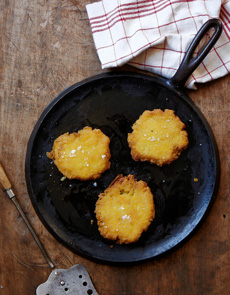 [4] Hoecakes, also called corn pone and johnny cakes, was the immigrant European’s version of the Native American cornmeal flatbread. Here’s the recipe from the Wall Street Journal (photo Christopher Testani | Wall Street Journal).
|
|
|
CHECK OUT WHAT’S HAPPENING ON OUR HOME PAGE, THENIBBLE.COM. |
||
